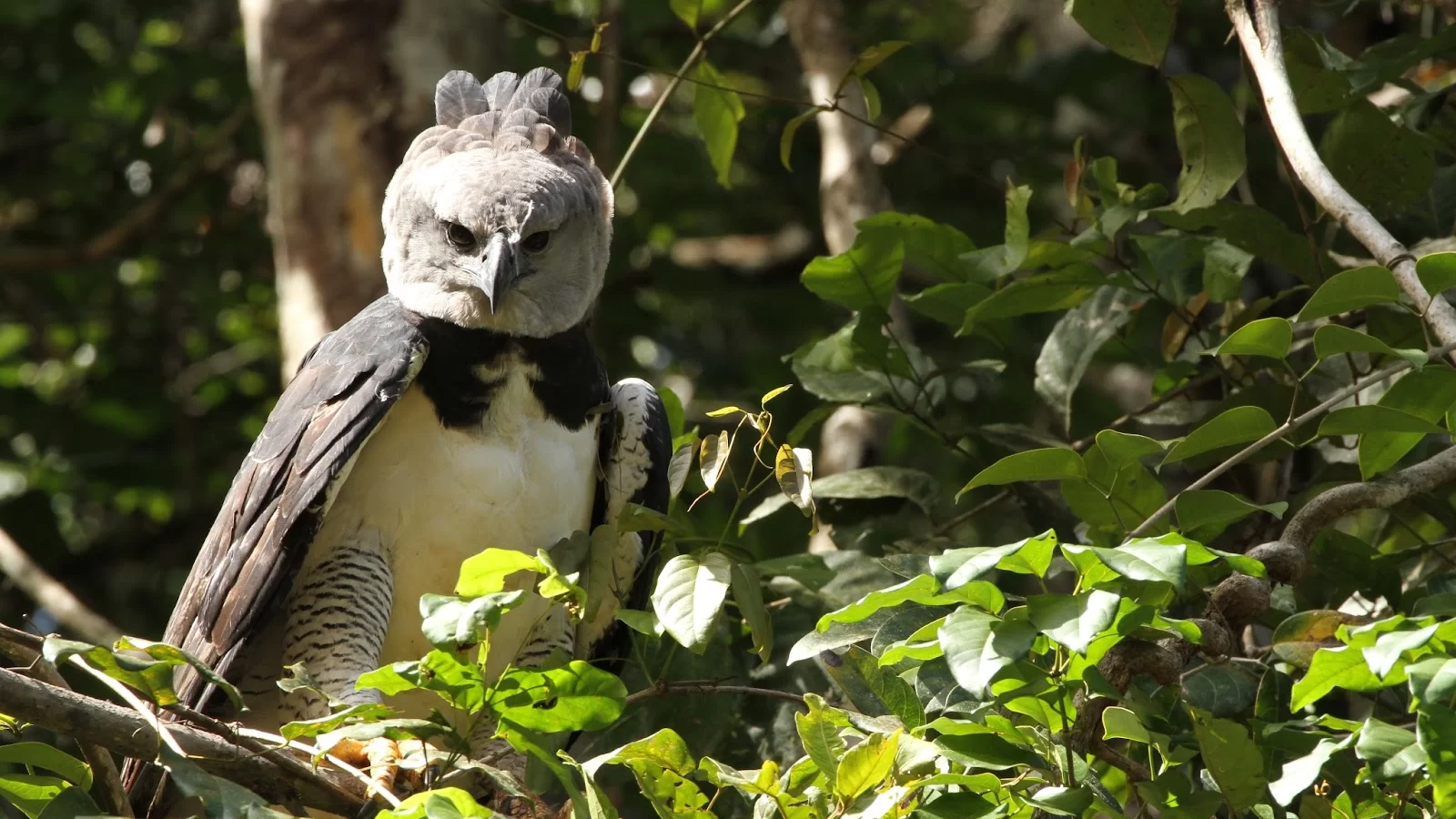Boating through the quiet lagoons of the Essequibo River in Guyana guided by Macushi Amerindian Leonard Williams, global angler Tom Armitage and his sister Emily go deep into the Iwokrama rainforest in search of the pirarucu, a magnificent fish also known as the arapaima.
This obligatory air breather can grow up to 15 feet in length and weigh upwards of 400 pounds. The arapaima’s iridescent scales of armor reflect the sun with glittering light as it gracefully ascends and descends into the dark pools of water every 20 minutes with its long serpent-like body.
Most anglers will never get the chance to be so close to such a prehistoric-looking species which makes this rare opportunity to catch and release one in its native waters even more appealing to anglers like the Armitages who make the long trek from England to this remote destination to find it.
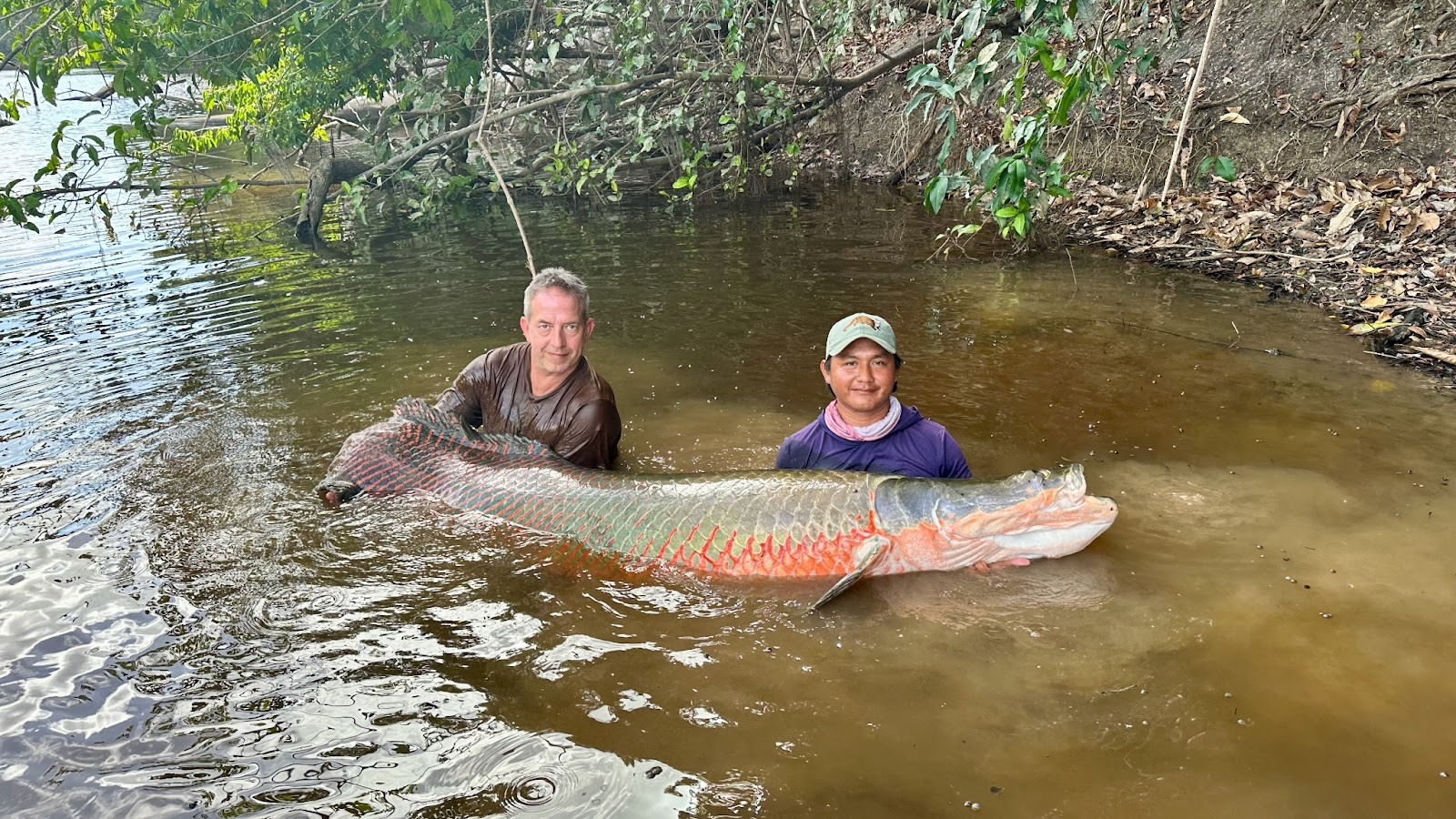
Tom Armitage and his Guyanese indigenous guide Leonard Williams with an Arapaima. Photo by Emily Armitage
“There’s nothing like the experience of being in a small lagoon surrounded by trees and birds and then you hook this huge fish that seems like it belongs in the sea,” said Tom Armitage.
Surrounded by the untouched natural beauty of the dense jungle, anglers on the Essequibo River are transported into a fantasy-world in the rainforest that bears no resemblance to modern society. Just getting there requires flying by prop plane into the rainforest, then boating up the river to a small lodge located hours from the closest village. Anglers see no other people for almost the entire time until they prepare to return home.
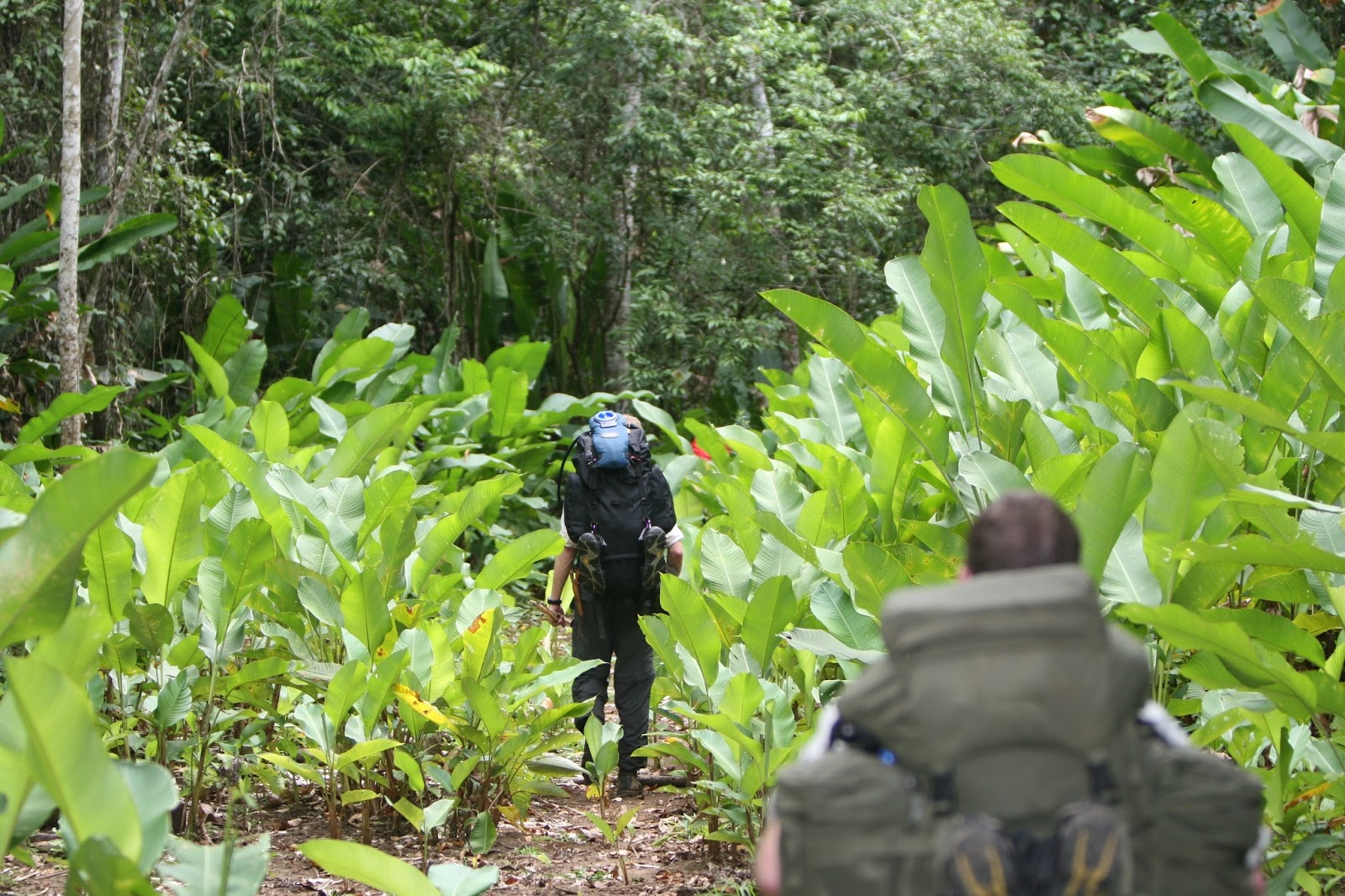
Hikers trek through Guyana’s dense jungle. Photo by Ian Craddock
Culturally diverse Guyana is an adventurer's paradise for fishing, hiking, trekking, and birdwatching in a relatively untouched natural environment. There is a range of ecosystems, biodiversity, pristine rainforests, vast savannahs, and Kaieteur Falls, the world’s largest single drop waterfall that attracts tourists who are looking for off-the-grid adventures. While Guyana is not as popular for tourism as other South American countries like Brazil and Colombia, that is part of its appeal to those who seek more intimate experiential travel by going to remote regions.
As travel trends point to the growing popularity of off-the-grid travel, Guyana is a prime example of how unfrequented destinations face the strategic challenge of attracting tourists while also preserving the environmental integrity of the natural resources that appeal to them in the first place.
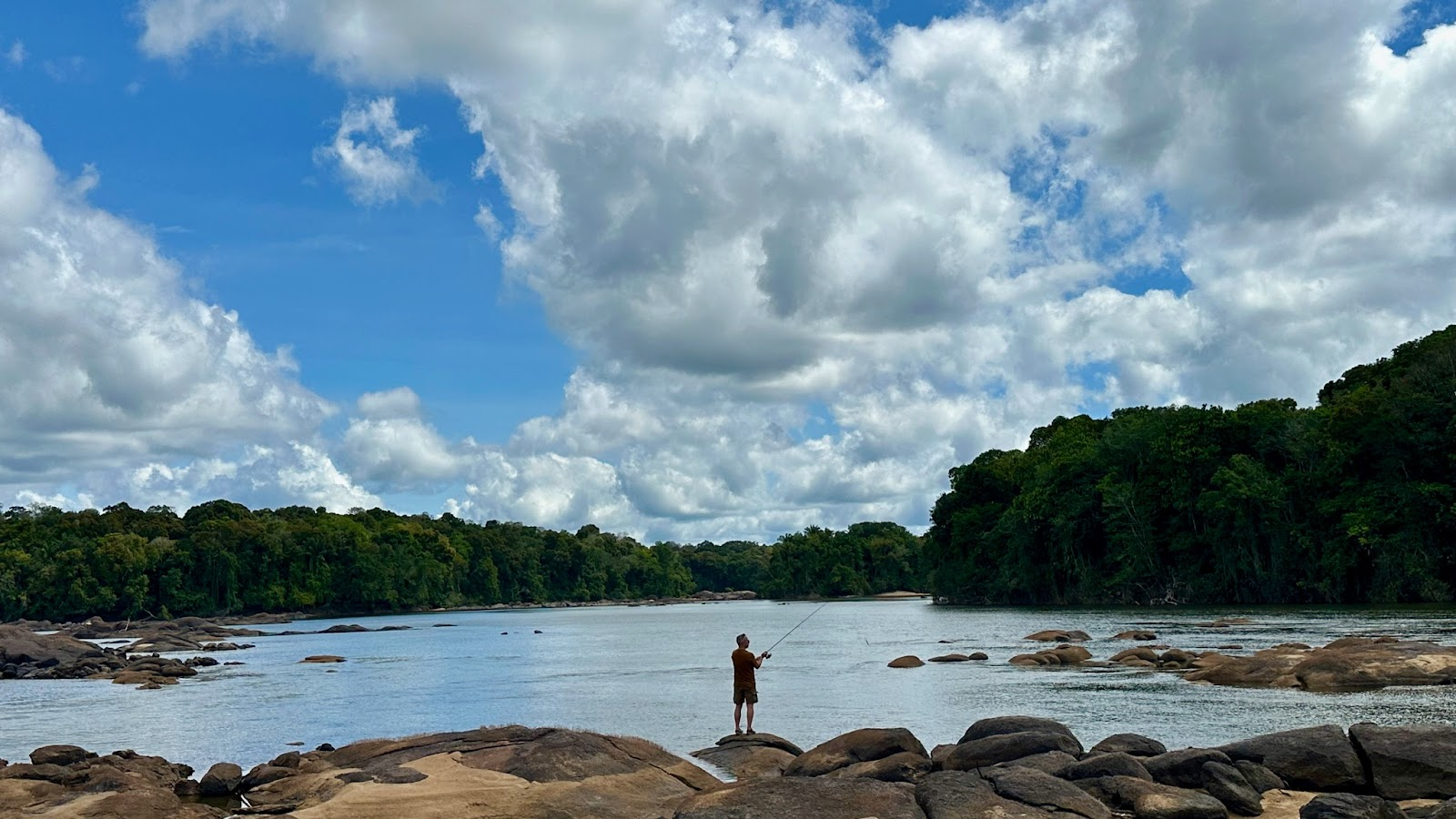
Tom Armitage fishing in the heart of Guyana’s remote Iwokrama rainforest. Photo by Emily Armitage
The appeal of off-the-grid-travel
Tom Armitage has fished around the world, but he chooses to return to Guyana’s pristine rainforest for his passion because it is a multi-species fishing destination, and the environment is unmatched when it comes to showcasing nature in its purest form.
“It makes me feel like an 1800s explorer,” said Armitage. “You feel like you’ve been somewhere that no one else has ever been and discovered mythical creatures that no one knew existed. The experience brings out the child explorer side of me.”
Anglers can catch peacock bass, aimara (wolf fish), payara (vampire fish) and prized catfish like piraiba, jau and red tail. Fishing deep within the rainforest enables anglers to become intimately immersed in nature’s backdrop with the added spectacle of paired macaws flying overhead, electric blue butterflies, caimans perusing the waters for prey, anacondas sunning on the river’s boulders and the iconic jaguar perched in the trees, although it is rarely ever seen.
Guyana has many returning visitors like Armitage and his sister who have discovered the country’s hidden beauty and appreciate the solitude they discover with every adventure.
“While many destinations boast luxury hotels and renowned restaurants catering to the ever-discerning clientele, Guyana has since made its name as one of the leading off-the-beaten-path destinations for intrepid travelers,” said Kamrul Baksh, director of the Guyana Tourism Authority.
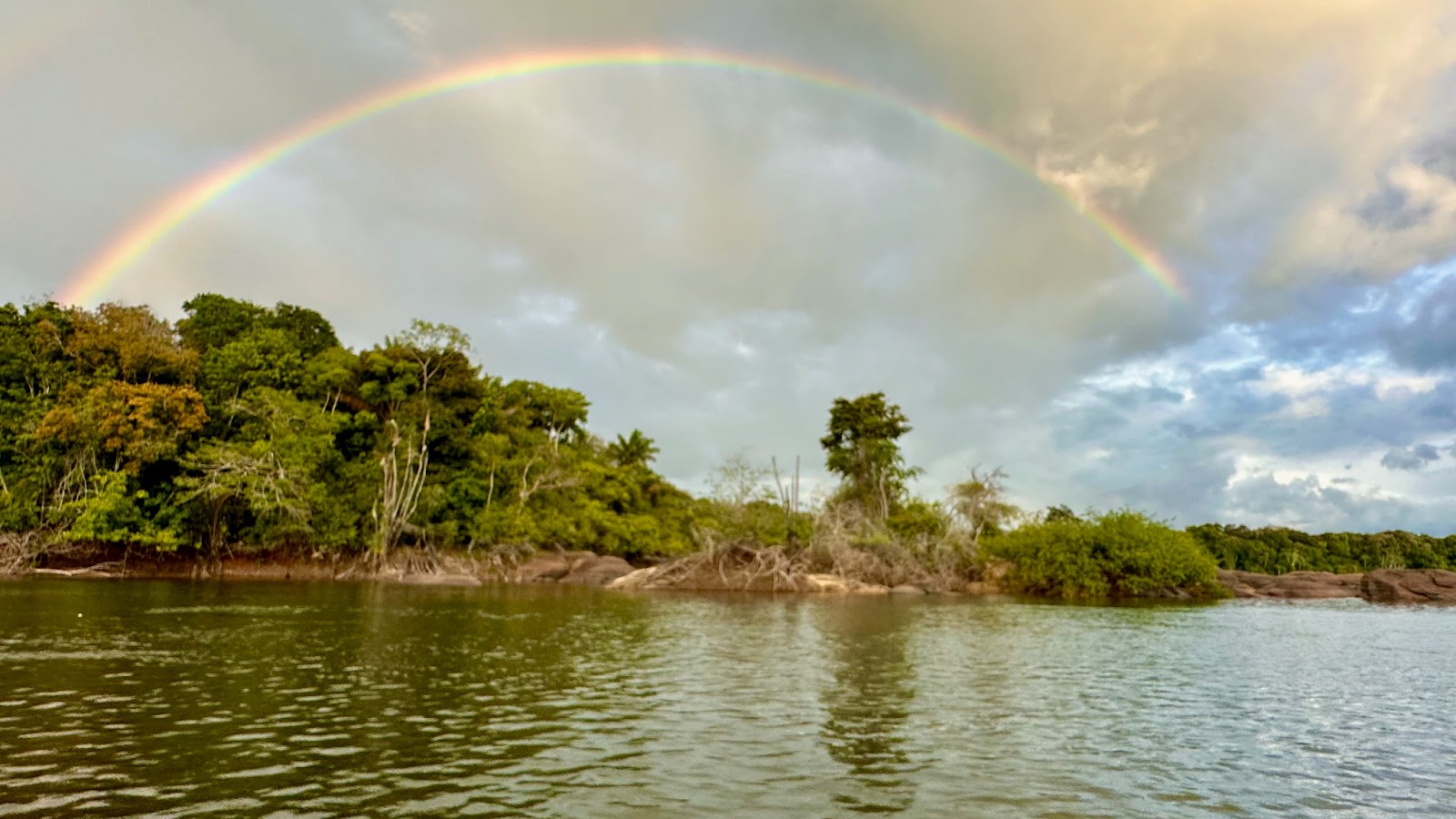
A rainbow stretches across the Essequibo River. Photo by Anietra Hamper
With most of the country’s citizens living along the coast, areas like Guyana’s interior rainforest, waterfalls, savannahs, mountains, and rivers are prime for exploration.
“This gives rise to the opportunity to have some extraordinary travel experiences virtually unheard of today, like the opportunity to travel great distances without seeing another human—or any sign of one, or the chance to explore the rich biodiversity and expansive primary rainforest found nowhere else on the planet,” said Baksh.
According to World Tourism Organization (UNWTO) statistical reports, the global tourism sector experienced fluctuations in 2021 and 2022 due to the COVID-19 pandemic. But Guyana’s tourism sector experienced strong growth during those years with visitor numbers increasing by more than 80-percent year over year. The growth continued into 2023 when the country recorded over 319,000 visitors reflecting a 10.7% increase compared to the same period of 2022. This is Guyana's highest-recorded number of visitors to date.
The threat of over-tourism in some destinations has unintended influences on nature and cultures. In places like Peru, over-tourism has eroded natural and cultural treasures like Machu Picchu to a breaking point. The country now limits or restricts visitors to some areas of the structure.
In Colombia’s indigenous villages along the Amazon River, tourism has negatively impacted the cultural integrity of the tribes that live within the jungle. Tourism has brought modern influences like music that attracts the attention of younger indigenous who are less interested in learning tribal ways than following their curiosity about the distractions of the outside world.

The Harpy eagle is a critically endangered species that inhabits the rainforest canopy in Guyana. Photo by Ashely Holland
Setting environmental tourism standards
There is little precedent or guidance on a global scale for how environmental tourism standards should be established, leaving the burden on individual countries to balance the environmental, social, and cultural impact.
The Global Sustainable Tourism Council (GSTC) is an agency focused on changing that by establishing guidelines for countries that they can use as a starting point to develop their own standards.
The GSTC sets global standards for sustainability in travel and tourism based on criteria that provides consistent language across the board and a baseline definition of what sustainable tourism looks like. Until now, there was no need for such a baseline, but increasingly remote destinations like Guyana that are attracting more tourists than ever before need this kind of guidance.
“GSTC’s mission is to be an agent of change in the world of sustainable travel and tourism by fostering the increased knowledge, understanding, adoption and demand for sustainable tourism practices,” said Estefania del Ashar, communications manager for GSTC.
The GSTC criteria are arranged in the categories of sustainable management, and socioeconomic, cultural, and environmental impacts.
The GSTC currently has 400 members that utilize its guidance for destinations and tour operators in developing sustainability standards that can be adapted to specific cultures, environments, customs, and laws in each destination.
“What is encouraging is that we see that tourism stakeholders, including governments, local communities, and industry leaders, are collaborating to create policies and infrastructure that support sustainability,” said del Ashar.
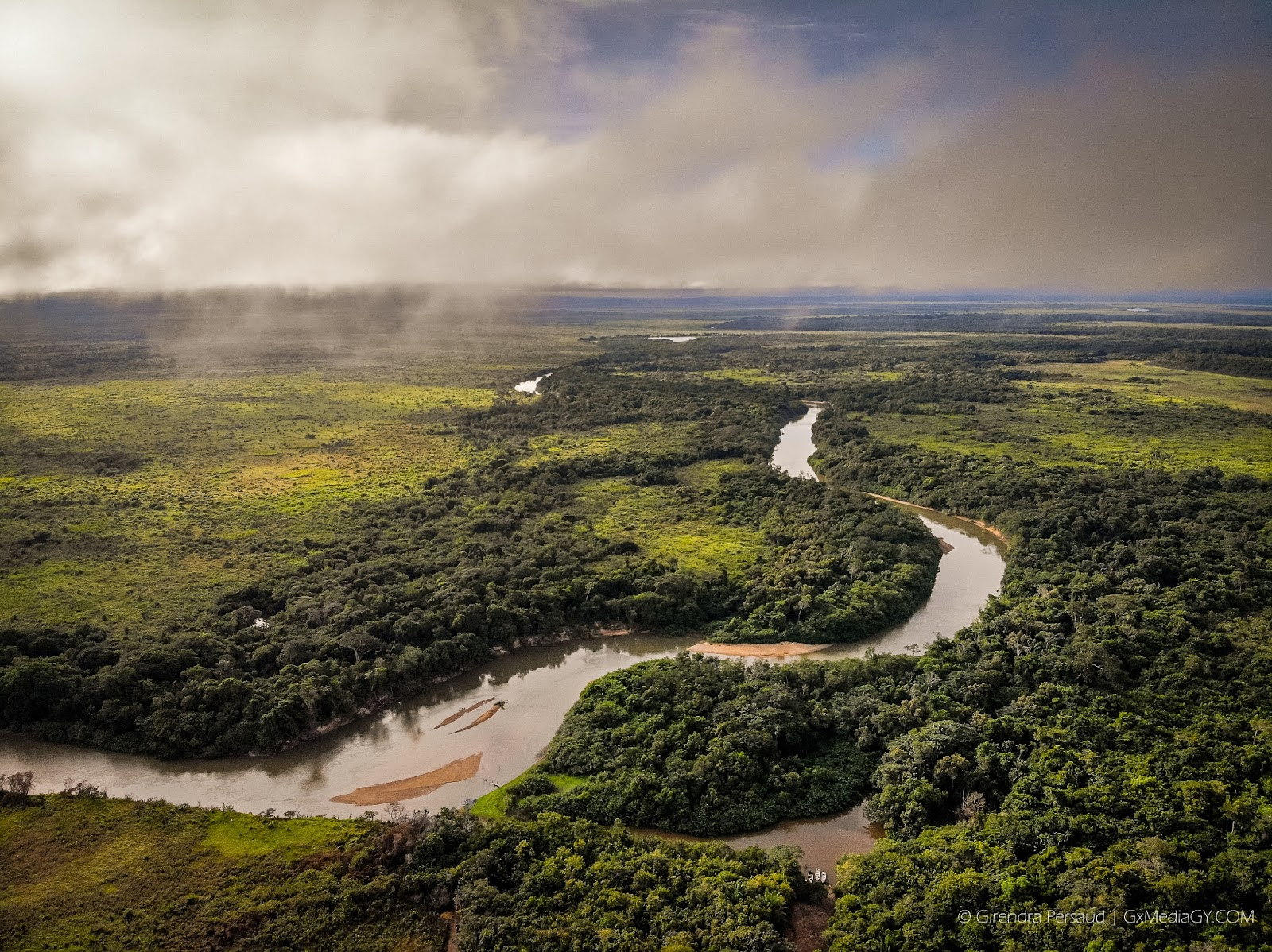
The Rupununi Region in southwest Guyana. Photo by Gierendra Persaud
Attracting the right kind of tourist
Guyana’s government entities recognize the potential tourism impact and are taking deliberate steps to establish environmental standards, attract the right kinds of travelers and bring local and indigenous communities to the discussion table.
Regions like the Rupununi in southwest Guyana, which has the largest concentration of indigenous Amerindian people, about 40-percent, has a strategic plan designed to attract tourists while preserving the region’s natural purity and tribal customs.
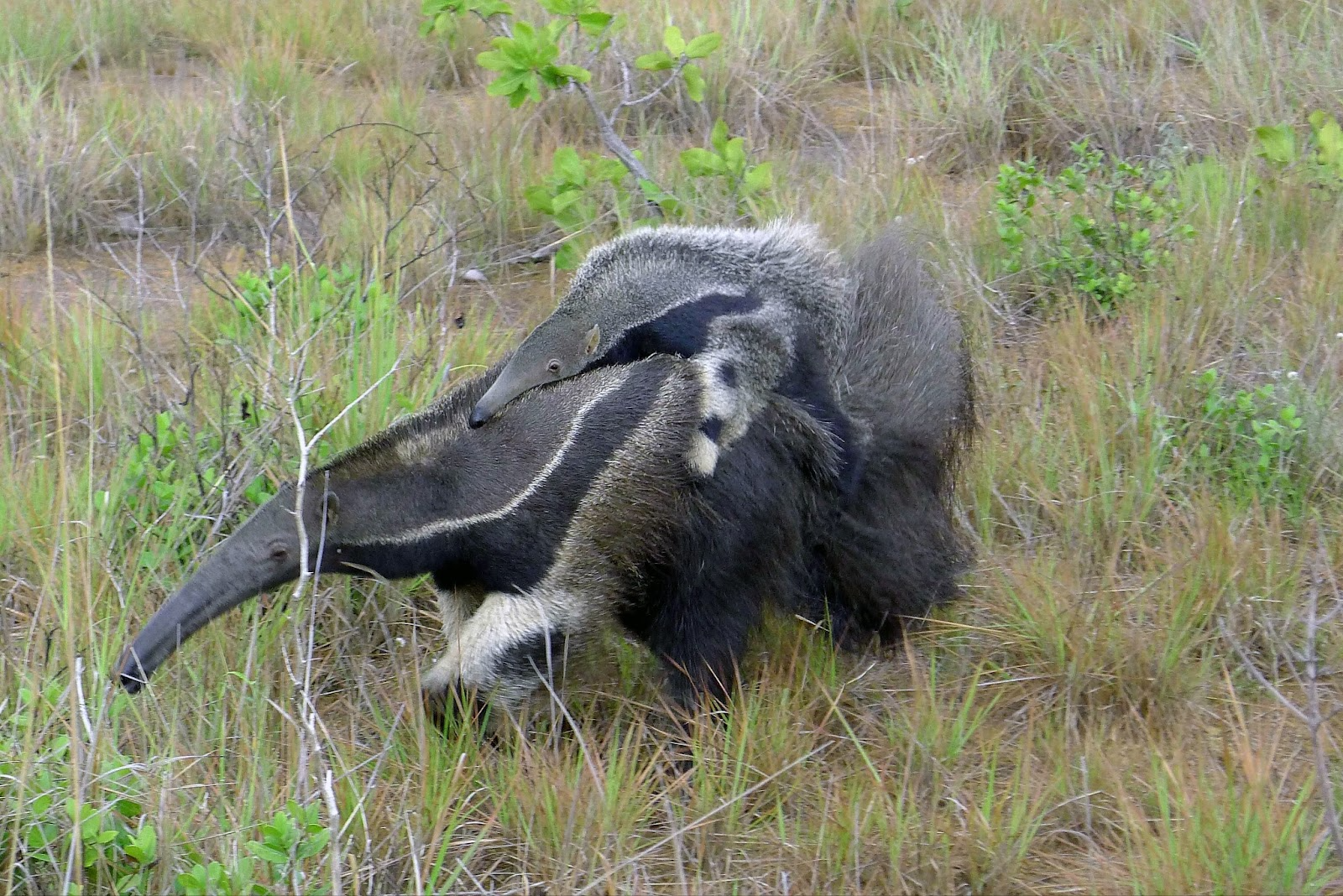
A Giant anteater and its baby in the Rupununi region. Photo by Gierendra Persaud
One of the ways they accomplish this is by targeting specific types of tourists through a campaign called Keep the Rupununi Wild. Their efforts draw visitors who share their values of preserving the land, its people and wildlife like the giant anteater and the endangered Harpy eagle.These efforts are reinforced by local businesses that commit to giving back by offering activities to tourists that support the local communities.
“The objective is to create sustainable tourism businesses that also support conservation and wildlife-friendly tourism,” said Melanie McTurk, president of Visit Rupununi. “These standards are to ensure that businesses are responsible, profitable, sustainable and mindful of the environment.”
The Keep the Rupununi Wild campaign outlines 13 values of wildlife-friendly tourism strategically marketing the Rupununi region as a conservation zone. It includes guidance on respecting local laws, traditions, and rituals when tourists visit villages and ensures that tourist activities are helping the local communities.
The campaign appears to work by engaging all stakeholders and making sure that everyone from the tourist and tour operators down to the indigenous tribes all get something out of the tourism efforts.
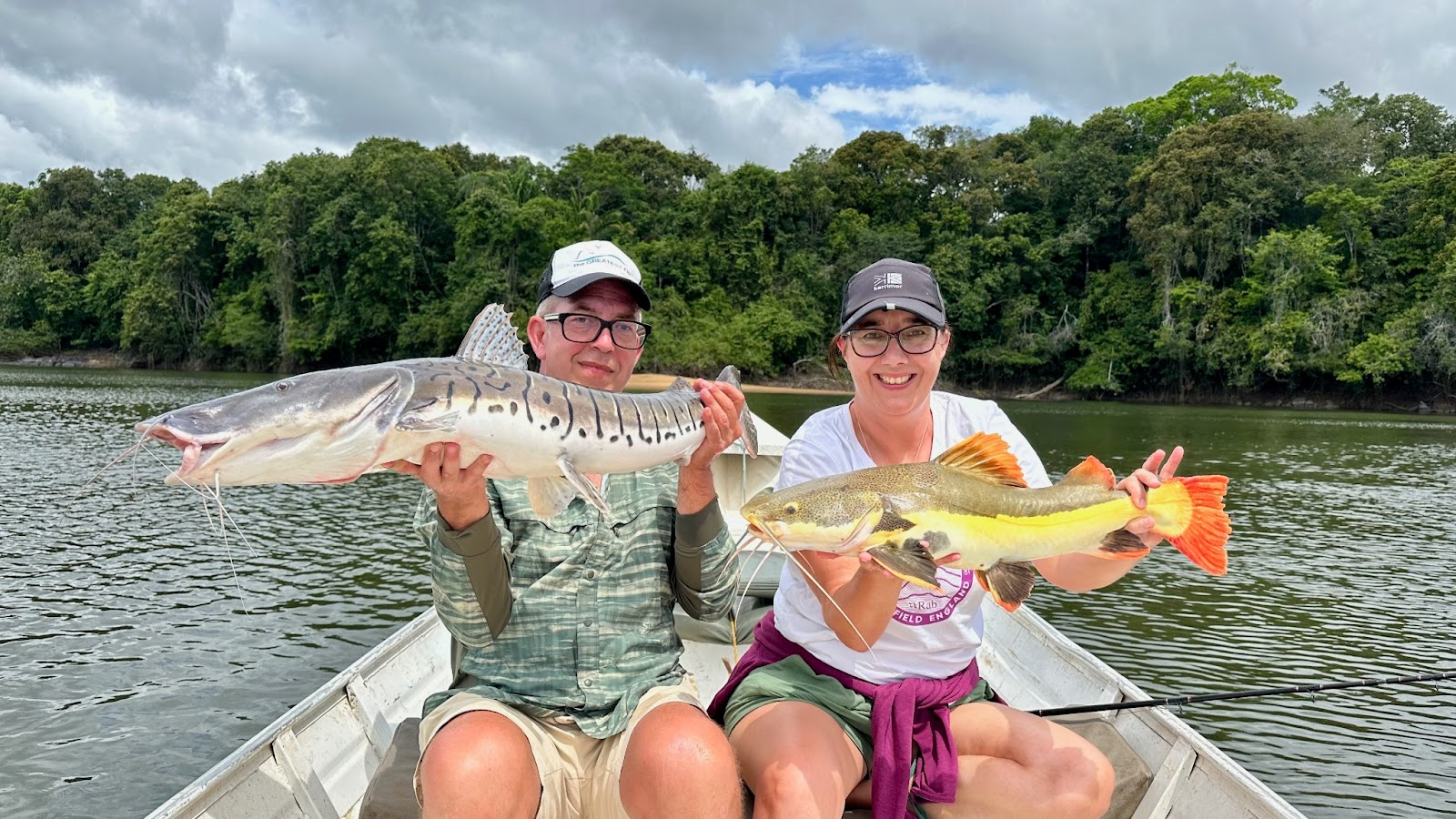
Siblings Tom and Emily Armitage holding recent catches fishing on the Essequibo River. Photo courtesy of Emily Armitage
A positive impact
Visitors like the Armitages are the kind of travelers Guyana tourism authorities want to host in their country. The Armitages have returned several times not just because of the fishing experiences but because they care about preserving the Guyanese culture and wildlife.
“It is a privilege to come to a place like this just to experience this in its natural and well-preserved state. I’ve been to 25 percent of countries, and this is the only place like it that’s not spoiled by other people. You always look for that on foreign trips, but you never find it because places are too developed. Here, you feel like you’re going back 1000 years,” said Armitage.
In places like the Rupununi region, bringing in more like-minded tourists who support the local efforts to preserve the indigenous culture, traditions, and language has made a difference because it gives the local people a way to showcase their native practices.
“The more modern tourist is one who is more interested in authentic cultures than a century ago. We are seeing tourists who are genuinely interested in the language and the culture, and who are curious about it. That gives the local people a sense of pride in their identity,” said McTurk.
McTurk explains that an erosion of language and culture happened due to decades of no educational system after Guyana’s independence from Britain in 1966. Many cultural groups languished because the younger indigenous people did not want to learn the traditional songs or the languages. Tourism has changed that in a positive direction.
“Today, many of the culture groups are populated by young people who are very proud of their history and their culture and excited to showcase it through language, music and dance. It helps to motivate the preservation of culture” said McTurk.
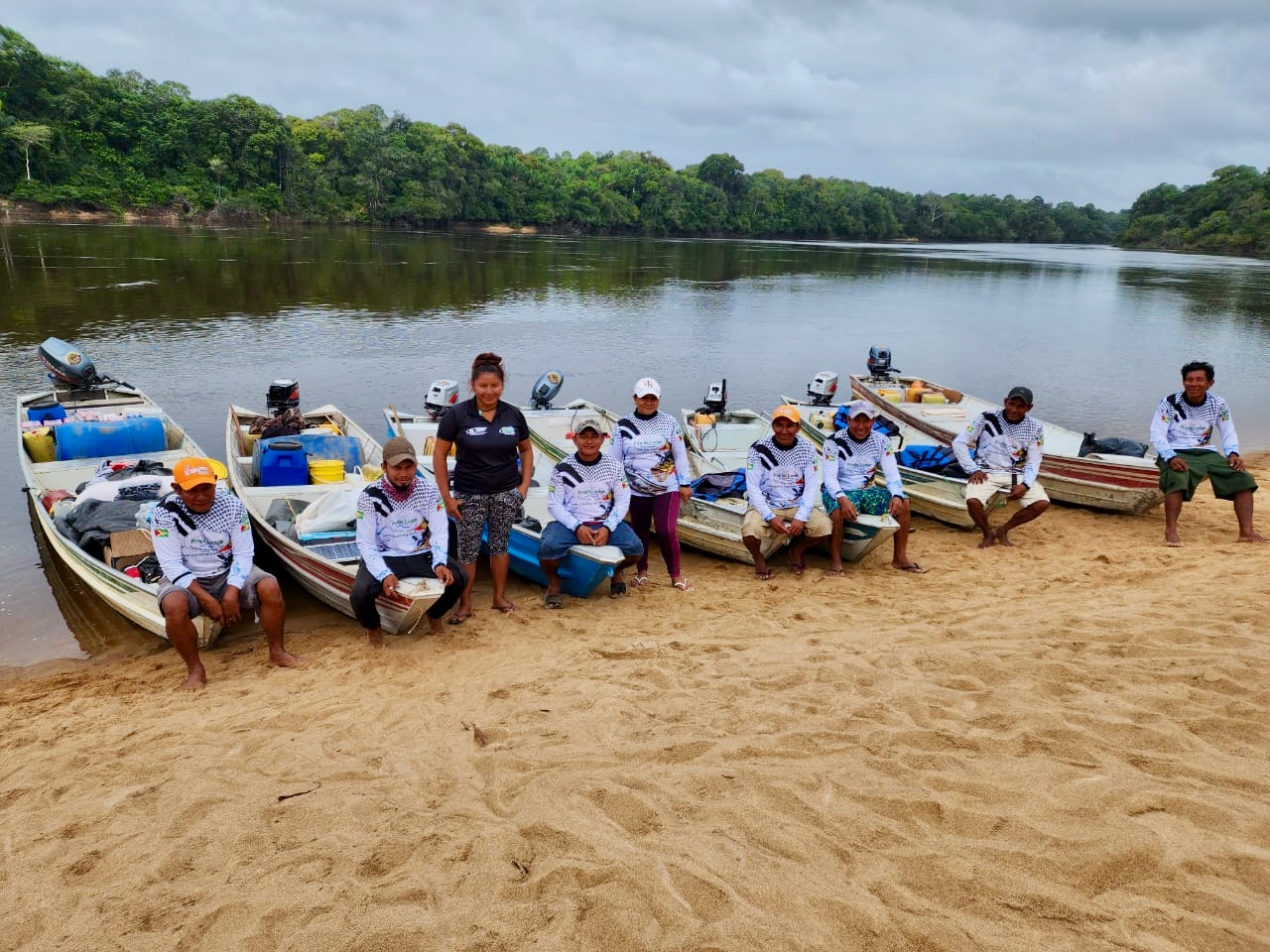
Indigenous fishing guides for Adventure Guianas on the Essequibo River. Photo by Navin Roopnarain
Motivating communities and tour operators
Preserving authentic cultural experiences also happens by motivating local communities and the tour operators within them to be conscientious of the impact that tourism has on culture.
Guyana’s diverse population comprises six races and nine indigenous tribes that tourists can engage with personally given that so many of the experiences are in the natural environment.
The trickle-down effect of this kind of cultural interaction is not lost on the Guyana Tourism Authority that promotes sustainable tourism practices. This includes licensing, and certification programs to recognize environmentally responsible tour operators who offer activities that distribute visitors so their impact is dispersed more evenly on the places they visit.
One of those certified tour operators is Adventure Guianas and Piraiba Lodge, a fishing and nature tour company.
"Adventure Guianas and Piraiba Lodge utilizes primarily indigenous guides, given their knowledge and experience, which allows for direct economic benefits to their respective communities. Additionally, we see them as custodians of our vast ecosystem, having utilized its resources for centuries, with minimal impact, which is fundamental to a living planet for future generations," said Navin Roopnarain, team leader of Adventure Guianas and Piraiba Lodge.
The tourism-environmental balance happens by engaging all stakeholders from the top down and supported by tour operators who are the link between visitors and the indigenous communities.
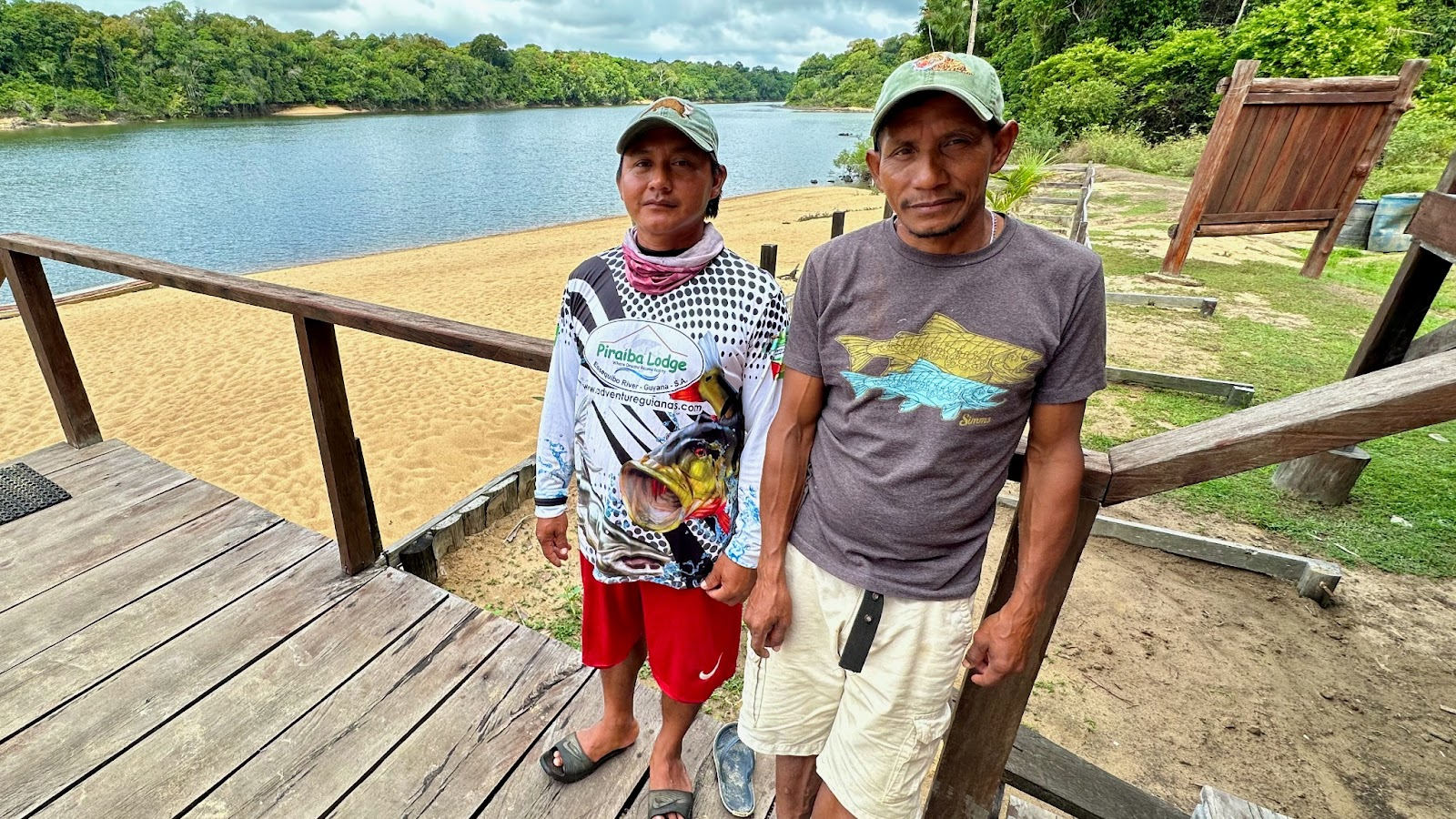
Adventure Guianas Amerindian fishing guides Leonard Williams and Mark Andries. Photo by Anietra Hamper
A lesser-known part of the equation is educating indigenous tribes about their part of not putting too much pressure on the wildlife and environment while still enabling them to do things like hunt and maintain their traditional culture.
Finding a balance between the growth in tourism trends and environmental and cultural preservation in remote destinations like Guyana is more complex than meets the eye but more important than ever before.
The definition of a balance is an ever-changing goal that requires all parties and potential impacts to be examined on a regular basis. This is the only way for tourists to be able to see stunning places like the back lagoons of the Essequibo River for once-in-a-lifetime experiences and feel good about doing their part.
